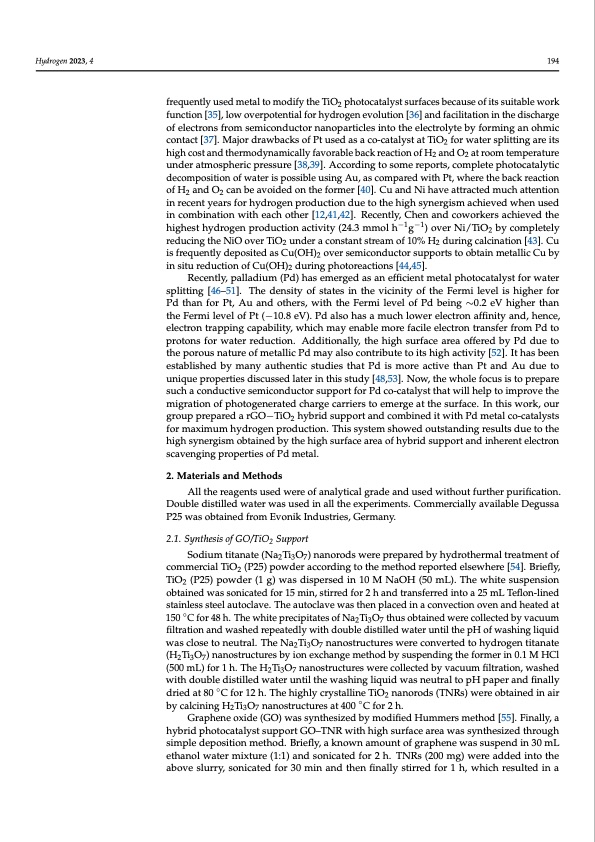
PDF Publication Title:
Text from PDF Page: 003
Hydrogen 2023, 4 194 frequently used metal to modify the TiO2 photocatalyst surfaces because of its suitable work function [35], low overpotential for hydrogen evolution [36] and facilitation in the discharge of electrons from semiconductor nanoparticles into the electrolyte by forming an ohmic contact [37]. Major drawbacks of Pt used as a co-catalyst at TiO2 for water splitting are its high cost and thermodynamically favorable back reaction of H2 and O2 at room temperature under atmospheric pressure [38,39]. According to some reports, complete photocatalytic decomposition of water is possible using Au, as compared with Pt, where the back reaction of H2 and O2 can be avoided on the former [40]. Cu and Ni have attracted much attention in recent years for hydrogen production due to the high synergism achieved when used in combination with each other [12,41,42]. Recently, Chen and coworkers achieved the highest hydrogen production activity (24.3 mmol h−1g−1) over Ni/TiO2 by completely reducing the NiO over TiO2 under a constant stream of 10% H2 during calcination [43]. Cu is frequently deposited as Cu(OH)2 over semiconductor supports to obtain metallic Cu by in situ reduction of Cu(OH)2 during photoreactions [44,45]. Recently, palladium (Pd) has emerged as an efficient metal photocatalyst for water splitting [46–51]. The density of states in the vicinity of the Fermi level is higher for Pd than for Pt, Au and others, with the Fermi level of Pd being ∼0.2 eV higher than the Fermi level of Pt (−10.8 eV). Pd also has a much lower electron affinity and, hence, electron trapping capability, which may enable more facile electron transfer from Pd to protons for water reduction. Additionally, the high surface area offered by Pd due to the porous nature of metallic Pd may also contribute to its high activity [52]. It has been established by many authentic studies that Pd is more active than Pt and Au due to unique properties discussed later in this study [48,53]. Now, the whole focus is to prepare such a conductive semiconductor support for Pd co-catalyst that will help to improve the migration of photogenerated charge carriers to emerge at the surface. In this work, our group prepared a rGO−TiO2 hybrid support and combined it with Pd metal co-catalysts for maximum hydrogen production. This system showed outstanding results due to the high synergism obtained by the high surface area of hybrid support and inherent electron scavenging properties of Pd metal. 2. Materials and Methods All the reagents used were of analytical grade and used without further purification. Double distilled water was used in all the experiments. Commercially available Degussa P25 was obtained from Evonik Industries, Germany. 2.1. Synthesis of GO/TiO2 Support Sodium titanate (Na2Ti3O7) nanorods were prepared by hydrothermal treatment of commercial TiO2 (P25) powder according to the method reported elsewhere [54]. Briefly, TiO2 (P25) powder (1 g) was dispersed in 10 M NaOH (50 mL). The white suspension obtained was sonicated for 15 min, stirred for 2 h and transferred into a 25 mL Teflon-lined stainless steel autoclave. The autoclave was then placed in a convection oven and heated at 150 ◦C for 48 h. The white precipitates of Na2Ti3O7 thus obtained were collected by vacuum filtration and washed repeatedly with double distilled water until the pH of washing liquid was close to neutral. The Na2Ti3O7 nanostructures were converted to hydrogen titanate (H2Ti3O7) nanostructures by ion exchange method by suspending the former in 0.1 M HCl (500 mL) for 1 h. The H2Ti3O7 nanostructures were collected by vacuum filtration, washed with double distilled water until the washing liquid was neutral to pH paper and finally dried at 80 ◦C for 12 h. The highly crystalline TiO2 nanorods (TNRs) were obtained in air by calcining H2Ti3O7 nanostructures at 400 ◦C for 2 h. Graphene oxide (GO) was synthesized by modified Hummers method [55]. Finally, a hybrid photocatalyst support GO–TNR with high surface area was synthesized through simple deposition method. Briefly, a known amount of graphene was suspend in 30 mL ethanol water mixture (1:1) and sonicated for 2 h. TNRs (200 mg) were added into the above slurry, sonicated for 30 min and then finally stirred for 1 h, which resulted in aPDF Image | Enhanced Photoreforming of Oxygenates

PDF Search Title:
Enhanced Photoreforming of OxygenatesOriginal File Name Searched:
hydrogen-04-00014-v2.pdfDIY PDF Search: Google It | Yahoo | Bing
Salgenx Redox Flow Battery Technology: Power up your energy storage game with Salgenx Salt Water Battery. With its advanced technology, the flow battery provides reliable, scalable, and sustainable energy storage for utility-scale projects. Upgrade to a Salgenx flow battery today and take control of your energy future.
| CONTACT TEL: 608-238-6001 Email: greg@infinityturbine.com | RSS | AMP |